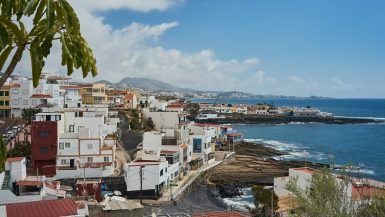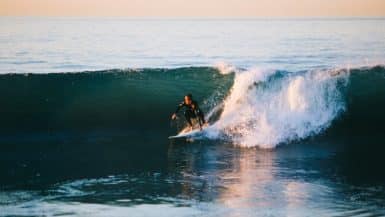
Whale watching in Tarifa is an unforgettable experience, providing memories that will stay with you for a lifetime. Tarifa is the southernmost region of the Iberian Peninsula in Spain. This is the world’s most popular place for wind sports out on the water which you’ll share with incredible Cetaceans.
Tarifa lies on the Coast de la Luz, facing Morocco and across the Strait of Gibraltar. The waters lapping at the shoreline are a mix of the Atlantic Ocean to one side and the Mediterranean Sea to the other, sharing the same waters as Portugal and the Madeira Islands. Several species of whales and dolphins pass through this section of the ocean as part of the migratory route.
If you’re keen to see some whales up close and personal, Tarifa is a fantastic place to hop on a boat and join a tour. Whale watching is one of the most wonderful and unique excursions you can do in Europe. It’s perfect for families, couples, and solo travelers.
Best Season To See Whales In Tarifa

Whale watching in Tarifa is best between April and October. The peak season is mid-June through to early September; during this time most tour operators can promise a high chance of seeing whales. Whales are in the Tarifa area throughout the year, however, sighting them in the summer months is more likely.
There are several types of whales that pass through the Strait of Gibraltar, including orcas and sperm whales. Orcas are typically seen in July and towards the end of the whale watching season. Sperm whales are often sighted between May and June during the Tarifa whale watching season.
Most experts recommend booking a boat tour at least twice at different times of the day. This will give you a broader spectrum and increase your chances of seeing whales and dolphins. Orca trips tend to run for around 3 hours, taking you further out to sea, while other whale watching tours typically run for 2 hours.
Prices For Whale Watching
Expect to pay between €40 and €200 per person for a seat on a whale watching boat, depending on how long you’ll be out on the water and the size of the boat. Children will have a lower ticket price. Some tour companies offer a free ticket in the event of not sighting any whales on your first trip. You will need to check this directly with the operators.
Overall, Tarifa is considered a fairly cheap vacation destination. If you’re traveling as a group or a family, you may want to rent an apartment instead of staying in hotels. This will keep your costs down and allow you to use the money on excursions, like whale watching tours.
The 4 Best Whale Watching Tour Operators

Book your trips with confidence with one of these four highly recommended whale watching tour operators. Be aware of high season crowds throughout July and August. You may need to book your whale watching in Tarifa experience in advance.
FIRMM Whale Watching
FIRMM Whale Watching is voted as the number one tour operator in Tarifa. You’ll experience a day of respectful whale watching with a knowledgeable crew on board. One downside is the boats are large, with a capacity of 100 passengers.
Information is provided in English and Spanish and sightings are announced throughout the boat via the speakers. Not only does this company organize trips for tourists, but they also work closely with research and conservation groups to ensure the safety and wellbeing of the cetaceans.
Turmares Tarifa
Turmares Tarifa is a local tour operator run by professionals and ocean lovers with a deep knowledge of the Strait of Gibraltar and the local inhabitants. This boat is slightly smaller than others and offers a submarine view below deck. Turmares Tarifa also works on environmental research and conservation projects throughout the year.
Marina Blue
Marina Blue is a premium tour option for whale watching in Tarifa. The small yacht has a maximum capacity of 10 passengers, making this an intimate experience with the whales and dolphins of Tarifa. You can charter the whole boat for one hour or a full day; if you have the budget, this is by far the best way to go whale watching in Tarifa!
Top Tarifa
Top Tarifa uses small speedboats to get up close and personal with whales and dolphins, offering a magical experience. The guides provide in-depth knowledge about the cetaceans you’ll see and know exactly where to go to get the best encounters. This may not be the best option for anyone who is nervous when out at sea.
Types of Whales in Tarifa
The Strait of Gibraltar is fed by the Atlantic Ocean and is the gateway to the Mediterranean Sea, providing a rich and diverse habitat with an array of sea creatures. There are several types of whales and dolphins in these waters that you could encounter.
Orca

The orca, also dubbed as the Killer Whale, is one of the most iconic marine animals in the world. They are a semi-resident species for the Spanish area and can best be seen between April and September. These whales are highly intelligent and work together when hunting.
Key features:
- Grow up to 10 meters in length
- Predominantly black body with a white underside
- High, sword shaped dorsal fin
- Diet consists of fish, squid, seals, marine birds, and tuna
Pilot Whale

Pilot whales live in the Strait of Gibraltar year-round and are extremely sociable. This is a medium-sized toothed whale, typically growing up to 7 meters in length. These whales rest on the ocean surface when the tides are going out, meaning they are one of the most commonly seen whales in Tarifa.
Key features:
- Grow up to 7 meters in length
- Dark grey or brownish in color
- Flat, sickle-shaped dorsal fin
- Long flippers
Sperm Whale

Sperm whales are another semi-resident species, passing through Tarifa’s waters between April to September whilst on their migratory path. These are the largest toothed whales and are expert divers, going down to depths of 3,000 meters. Sightings of sperm whales tend to be from a distance and are rarely in groups.
Key features:
- Grow up to 18 meters in length
- Dark grey to light brown in color
- Large head with blow hole on the left side
- Low hump in place of dorsal fins
Fin Whale

Fin whales are baleen whales found in the Strait of Gibraltar during the summer migratory season. After the blue whale, this is the largest animal in the world growing up to 22 meters in length. Sighting a fin whale is a privilege and an extremely special occasion.
Key features:
- Grows up to 22 meters in length
- Dark grey back with a white underbelly
- Small, falcate dorsal fin in the back third of the body
- Diet consists of krill, fish, and squid
Dolphins

Along with the whales, dolphins are a common sighting throughout the year in the waters around Tarifa. Three species can be seen: bottlenose, striped, and the common dolphin. Dolphins are famously playful and often put on a show for the whale watching tour boats.


